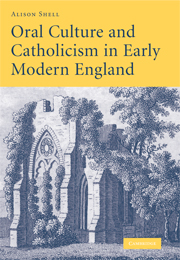Book contents
- Frontmatter
- Contents
- List of illustrations
- Preface
- Note on conventions
- List of abbreviations
- Introduction
- 1 Abbey ruins, sacrilege narratives and the Gothic imagination
- 2 Anti-popery and the supernatural
- 3 Answering back: orality and controversy
- 4 Martyrs and confessors in oral culture
- Conclusion: orality, tradition and truth
- Notes
- Index
1 - Abbey ruins, sacrilege narratives and the Gothic imagination
Published online by Cambridge University Press: 22 September 2009
- Frontmatter
- Contents
- List of illustrations
- Preface
- Note on conventions
- List of abbreviations
- Introduction
- 1 Abbey ruins, sacrilege narratives and the Gothic imagination
- 2 Anti-popery and the supernatural
- 3 Answering back: orality and controversy
- 4 Martyrs and confessors in oral culture
- Conclusion: orality, tradition and truth
- Notes
- Index
Summary
The Catholic antiquary Charles Eyston, writing in The History and Antiquities of Glastonbury, has a story to tell about the market house in the town:
It is a neat Pile of Building, built of late Years with some Materials the Town had from the old Abbey. But I was told by a Man of Credit, living in the Neighbourhood of Glastonbury, that the Town hath lost, in a great measure, their Market since it's (sic) Building, which he imputed to it's (sic) being built with Materials that belonged to the Church; and whoever reads Sir Henry Spelman's History of Sacrilege, will not wonder, that such a Fate should attend it.
This is one example of a sacrilege narrative, a story which demonstrates God's providence by showing the dire consequences of violating or demeaning a person, object or place publicly dedicated to the worship of God. The notion that sacrilege provokes divine wrath has a long history; as John Weever put it, ‘the depredation of Churches, Church robbing, or Sacriledge, was in all ages held most damnable … he that steals any thing from the Church, may be compared to Judas the traitour’. But Englishmen after the Reformation had particular cause to be nervous, since Henry VIII's dissolution of religious houses was held by many to be the worst example of sacrilege that England had ever seen.
- Type
- Chapter
- Information
- Oral Culture and Catholicism in Early Modern England , pp. 23 - 54Publisher: Cambridge University PressPrint publication year: 2007



